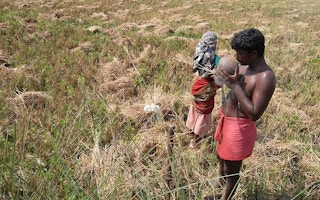The Apatani people of India’s Eastern Himalayas practise a unique form of farming where two crops of rice (mipya and emoh) and one crop of fish (ngihi) are raised together. The wet rice fields are irrigated through well-managed canal systems managed by diverting streams that originate in the surrounding forests into a single canal — connected with bamboo or pinewood pipe. The paddy and fish ponds are strategically positioned to receive all the run off from the hills.
They have been farming around the Yero Valley for centuries and their reverence for nature is at the centre of all their practice. Their rice cultivation is often why the Apatani people are considered one of the most advanced tribal communities in northeastern India. They have been known for their rich economy for decades and good knowledge of land, forest and water management.
Due to these special attributes of sustainable farming systems and people’s traditional ecological knowledge in sustaining ecosystems, the plateau is in the process of being declared a UNESCO World Heritage centre.
Agricultural systems driven by Indigenous knowledge can absorb shocks from multiple climate extremes. But this wealth of knowledge, passed from elders across generations, is not often well documented. The key to preserving it is to engage, learn and incorporate these lessons into wider society.
Strict customary laws by the Apatani people govern the use of forest resources and hunting practices to ensure the environment is not being exploited. The availability of irrigation water for rice in the Eastern Himalayas is made possible due to efficient forest conservation around the valley.
Their farming practices integrate the existing landscape and use as many local resources as possible to maintain the natural ecosystem, including their fertiliser, pesticides, irrigation channels and seeds. The entire cultivation procedure is organic and devoid of artificial soil supplements. The crops are supplemented with livestock manure, agricultural waste, kitchen waste, and rice chaff that help maintain soil fertility. Irrigation, cultivation and harvesting require cooperation, experience, contingency plans, and a disciplined work schedule.
The 705 ethnic groups in India make up an estimated 104 million people. There are 200,000 Irular in the wet and humid Western Ghats. There are the 13,000 Apatani people who have lived for 600 years in the high-altitude valleys in the eastern Himalayas, where rainfall is also abundant. But the Lahaula call the dry and snowy mountains of Lahaul and Spiti in the western Himalayas home. With very little rainfall, its 31,000 people mostly rely on snow as their water source. In contrast, the Dongria-Gondh people live in the hot and humid Niyamgiri hills in the state of Orissa. They thrive on small streams from the hills.
These four Indigenous populations come from very different eco-geographical regions but all are facing the impacts of climate change — increasing days with high temperatures, unpredictable monsoons and weather extremes. Specifically, flash floods in the eastern Himalayas, drought in the Eastern Ghats, glacier retreat and water stress in western Himalayas and pest invasion in the Western Ghats.
There are several common agricultural practices among the populations which can be the first line of defence against the impact of climate change. The surrounding forest and sustainable practices are essential to food security for all four.
Each practises collective farming and uses local resources whenever available. The division of labour in each stage of farming has developed experts with specialised skills who pass their knowledge among families. Farm work essential to maintaining the entire system includes irrigation, fencing, building footpaths, weeding, field preparation, transplantation, harvesting and storing. Different families are responsible for a specific task with roles passed down through generations, creating strong bonds, co-dependencies and a sense of pride in their role within the community.
Once crops are harvested, some seeds are kept for the following year’s cultivation. The rest is consumed as food. Genetically modified seeds, which are commonly used in modern farming, have a significantly shorter shelf life and cannot be kept until the next planting season as they are either unable to germinate or give poor production. Farmers would have to buy those again. Instead they use native seeds which can be stored — the result of thousands of years of natural farming conserved through generations.
Crops are commonly planted together — grown on the same land, at the same time which lessens the chance of a pest attack, as pests are crop specific. Fruit, spice, vegetables and cereals can be cultivated together, taking advantage of their different heights by using the land vertically, not just across the ground.
Some planted varieties are drought tolerant, some are heat tolerant, some have a shorter growing time and others need a longer growing time. For example, the Dongria-Gondh people grow 80 crop species simultaneously ranging from resilient Indigenous varieties of paddy, millet, leaves, pulses, tubers, vegetables, sorghum, legumes, maize and oil seeds that have been maintained for decades.
Planting all at the same time provides a level of security in the case of extreme events such as floods and drought, as not all would be wiped out. Kala mali phulo is one variety of rice cultivated by the Dongria-Gondh people. This rice variety does not require lots of water and can withstand environmental changes.
The Irular people of India’s Western Ghats have been farming around the Palamalai and Nilgiri hills for centuries. The high rainfall and wet and humid weather of the region throw up the challenge of how best to preserve seeds harvested each year for the next year’s planting.
Keeping seeds for a year puts them at risk of rot and pests. Storing them using modern techniques such as cold storage facilities is expensive and emits greenhouse gas emissions. So the Irular store paddy grains with aromatic herbs in a small mudhouse, millet under the soil in a container painted with cow-dung slurry and preserve pepper seeds in a hanging gunny bag to maintain the longevity of their grains. They also use plant-based pesticides and repellents from the common Indian plant, Neem. Neem oil, neem seed extracts, garlic-chilli paste and tobacco water solution are used to kill and repel pests.
Due to the snow, the Lahaulas from western Himalayas can only grow crops for six months so they have developed a long-composting method to counter essential nutrient loss when snow melts. They have several community composting rooms where livestock manure, human excrement, kitchen waste and forest leaf litter are aggregated throughout winter. As the temperature falls below freezing, the composting takes a longer time. When summer comes and fields become snow-free, compost materials are applied in the field. They also intensely integrate livestock into their farming system to eat and for compost.
Indigenous people are migrating and changing their traditional livelihood now more than ever due to the destruction of land and forests. As their population sizes are already relatively small, ancient knowledge is increasingly in danger of being lost. Creating a well-documented national repository of them will ensure their preservation and longevity, particularly as we face weather extremes caused by climate change that threaten our food security.
The Intergovernmental Panel on Climate Change recommends including Indigenous knowledge in climate change adaptation plans locally and internationally and now is the time to listen to ways we can better save our crops from heat waves, droughts and floods. It seems the knowledge has always been there, we just need to learn from those who hold it.
Arindam Roy is a scientist in LAPI lab, École polytechnique fédérale de Lausanne. He co-founded the first Bengali Climate Communication Platform (Sobuj Prithibi). He also runs The Climate Thinker, an organisation working on climate education in India.
Originally published under Creative Commons by 360info™.











